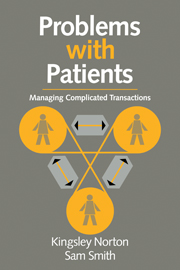Book contents
- Frontmatter
- Contents
- Foreword by Professor Paul Freeling, O.B.E.
- Preface
- Acknowledgments
- 1 Doctor–patient interaction
- 2 The clinical transaction
- 3 Interpersonal influences
- 4 The influence of past relationships
- 5 Contextual influences
- 6 Managing complicated clinical transactions
- 7 Interventions in complicated clinical transactions
- 8 Implications for the clinical setting
- 9 Implications for training
- Appendix I Clinical phenomena related to ‘problem patients’
- Appendix II Personality disorder
- References
- Index
1 - Doctor–patient interaction
Published online by Cambridge University Press: 19 March 2010
- Frontmatter
- Contents
- Foreword by Professor Paul Freeling, O.B.E.
- Preface
- Acknowledgments
- 1 Doctor–patient interaction
- 2 The clinical transaction
- 3 Interpersonal influences
- 4 The influence of past relationships
- 5 Contextual influences
- 6 Managing complicated clinical transactions
- 7 Interventions in complicated clinical transactions
- 8 Implications for the clinical setting
- 9 Implications for training
- Appendix I Clinical phenomena related to ‘problem patients’
- Appendix II Personality disorder
- References
- Index
Summary
The best kind of patient... is one who from great suffering and danger of life or sanity responds quickly to a treatment that interests his doctor and thereafter remains completely well; but those who recover only slowly or incompletely are less satisfying.
Dr Tom Main (1957)Introduction
Mr Taylor entered the consulting room almost stealthily and took his seat. The doctor's greeting was received silently with a somewhat jeering smile. Mr Taylor had a shifty appearance, accentuated by the wandering of his gaze, which was hardly ever allowed to engage the doctor's. He began to detail his minor complaints, which were numerous. The doctor, looking at his own notes, saw uncomfortably that Mr Taylor was regularly prescribed five different medications, three of which might potentially interact in a harmful way. As he listened, endeavouring to make contact with Mr Taylor's wandering gaze, the doctor's shoulders drooped as if in resignation. From long experience he sensed nothing would change as a result of this clinical encounter. Mr Taylor left with a prescription to continue all five drugs, a prescription written guiltily and received with an almost sadistic smile, the only steady eye contact of the consultation.
The above clinical vignette based on an actual doctor–patient interaction (videotaped and discussed by trainer and trainee) represents a consultation with which most doctors are familiar. Mr Taylor is a so-called ‘problem patient’. He does not appear to experience great suffering and certainly does not have a life-threatening disease. In spite of repeated consultations little progress is made in alleviating his multiple complaints.
- Type
- Chapter
- Information
- Problems with PatientsManaging Complicated Transactions, pp. 1 - 18Publisher: Cambridge University PressPrint publication year: 1994



